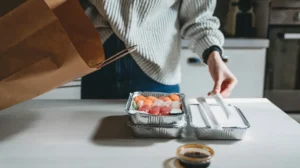Sushi is an exquisite culinary experience that can be enhanced with elegant plating techniques and presentation skills. Learn how to craft sushi rolls using fresh ingredients for an exquisite dining experience.
When plating sushi, it’s essential to take into account color, flavor and texture. Contrasting hues can add visual interest, while using the rule of thirds will help position your food on your plate in an appealing way.
1. Choose the Right Plate
Begin creating an impressive sushi dinner for your guests by selecting the ideal plate. Sushi plates come in various materials, styles and colors; one safe choice would be one made of melamine plastic which can be used with raw fish; otherwise you may prefer traditional Japanese dishware such as lacquered katsuobushi (lacquered) or Bizen ware which provides an elegant aesthetic for food presentation.
Learning proper etiquette for sushi dining is essential to its enjoyment and success. When greeting an itamae (sushi chef), be polite to respond with “Irasshaimase.” Additionally, asking their advice as they will most likely hand select fresh seasonal fish to put on your plate demonstrates trust with them and is acceptable behavior.
When it comes to arranging sushi, keep Wabi Sabi in mind – a traditional Japanese aesthetic that celebrates beauty in imperfection. To exemplify this aesthetic, don’t be intimidated to scatter or cluster your sushi instead of placing it neatly in rows; doing this will give it more character and make it seem more inviting for guests. You could also add an interesting modern touch by using textured sushi platters which provide depth.
2. Arrange Your Sushi
If you’re hosting a sushi party, arranging the ingredients so as to maximize guest enjoyment is paramount. Not only can an appealing presentation increase its visual appeal; also its arrangement can enrich both flavor and texture of each bite of sushi served up!
Garnishes such as lemon zest and gari can help cut through the richness of tuna or salmon sushi dishes, while adding an element such as scallions can enhance its flavors in an eel-based sushi platter.
Not only can the right garnishes elevate the taste and texture of sushi, they can also make your dining table more festive and welcoming. Consider including decorative items such as origami cranes, Japanese lanterns, river rock pebbles or paper fans to set the stage for your culinary masterpieces.
As your guests may be unfamiliar with raw seafood, when making sushi it is essential that they receive plenty of acclimating foods such as cooked vegetables, soups and rice dishes so they can experience its unique flavors before deciding whether they want more. Hikarimono rolls (eel rolls) could also help cleanse palates after more heavy pieces. And don’t forget refreshing drinks such as green tea, warm sake or cold beer for their guests to drink after enjoying your delicious dishes!
3. Add Fresh Garnishes
Any sushi enthusiast knows that sushi’s art lies not only in its preparation, but also its presentation. A beautifully laid out plate brings more pleasure by showing the skill of its maker and emphasizing his or her care in crafting each piece of sushi.
As you arrange your sushi, take care to achieve visual equilibrium and color contrast. Use a range of hues to add depth and interest, contrasting light-colored sushi with dark garnishes (and vice versa) while garnishes can add textural interest with elements like tobiko (flying fish roe) or thinly sliced avocado creating striking contrasts against soft, smooth textures such as those found in certain rolls.
An cucumber and tuna roll would benefit greatly from adding some tobiko for visual interest as well as flavor enhancement. This contrast adds visual appeal while simultaneously increasing flavor!
Another key consideration when serving sushi is not using too much wasabi. Too much wasabi can overpower the delicate flavors of fish and rice, so only use small amounts on one side of each piece of sushi. Many restaurants also provide pickled ginger as a palate cleanser to balance out its spicy kick.
With these tips in mind, you can enjoy sushi either at home or take your skills to the next level at one of your favorite restaurants. Don’t forget that having fun should always come first!
4. Consider Visual Balance and Color Contrast
Sushi is an exquisite culinary tradition that showcases the artistry of its creator. Every aspect from selecting only premium ingredients to artistic plating requires careful consideration and craftsmanship from chef.
Plating sushi requires taking into account visual balance and color contrast, and one way of accomplishing this is using different colored plates. While white dishes tend to provide greater visual interest due to their high contrast appearance, other hues such as black or blue could add interest when presented alongside rolls featuring various filling colors.
Additionally, it’s essential not to overcrowd your plate with too many components. Clutter can detract from the flavor and texture of sushi; keep things as simple as possible! Adding garnishes or sauces add contrast and color, but should never overshadow its essence.
Most people associate sushi as being solely composed of raw fish; however, its true definition consists of rice seasoned with vinegar and filled or topped with various cooked and uncooked meats, vegetables and seafood dishes. Due to this definition of sushi as well as the many types that do not contain raw fish for vegetarian diners to enjoy; sushi can also be served alongside beverages such as hot green tea or genmaicha (green tea combined with roasted brown rice) which contain antibacterial properties that help prevent food poisoning when eating sushi.


